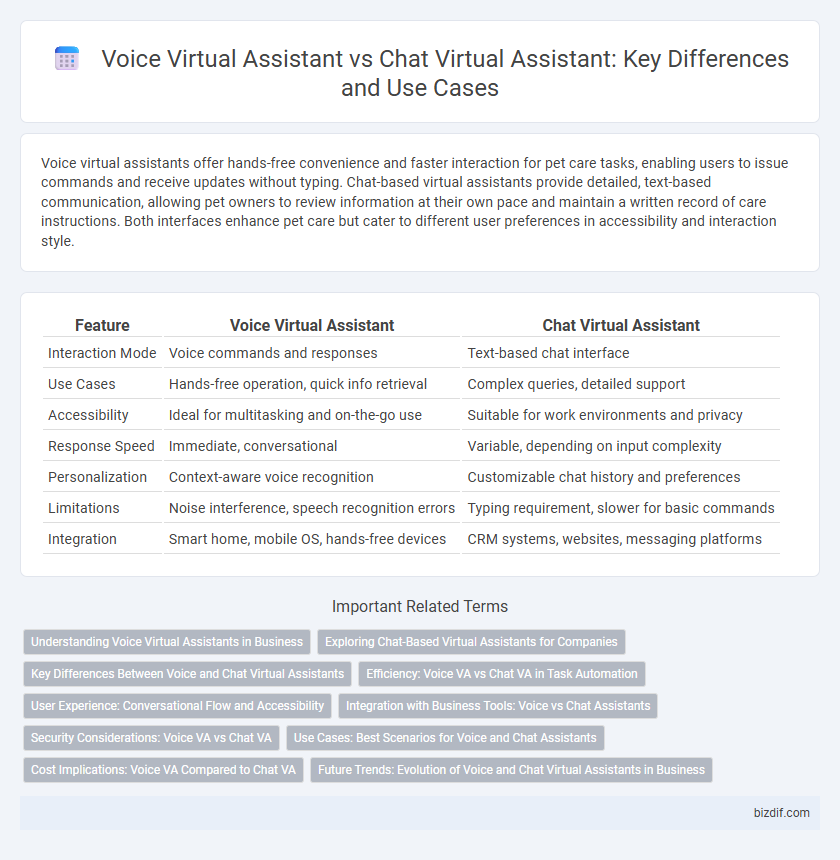Voice virtual assistants offer hands-free convenience and faster interaction for pet care tasks, enabling users to issue commands and receive updates without typing. Chat-based virtual assistants provide detailed, text-based communication, allowing pet owners to review information at their own pace and maintain a written record of care instructions. Both interfaces enhance pet care but cater to different user preferences in accessibility and interaction style.
Table of Comparison
| Feature | Voice Virtual Assistant | Chat Virtual Assistant |
|---|---|---|
| Interaction Mode | Voice commands and responses | Text-based chat interface |
| Use Cases | Hands-free operation, quick info retrieval | Complex queries, detailed support |
| Accessibility | Ideal for multitasking and on-the-go use | Suitable for work environments and privacy |
| Response Speed | Immediate, conversational | Variable, depending on input complexity |
| Personalization | Context-aware voice recognition | Customizable chat history and preferences |
| Limitations | Noise interference, speech recognition errors | Typing requirement, slower for basic commands |
| Integration | Smart home, mobile OS, hands-free devices | CRM systems, websites, messaging platforms |
Understanding Voice Virtual Assistants in Business
Voice virtual assistants leverage advanced natural language processing and speech recognition technologies to enable hands-free, real-time interaction, improving operational efficiency in businesses. Compared to chat virtual assistants that rely on text-based communication, voice VAs offer faster customer response times and enhanced accessibility for multitasking environments. Integrating voice VAs in customer service or sales processes reduces wait times and increases user engagement through more natural conversational experiences.
Exploring Chat-Based Virtual Assistants for Companies
Chat-based virtual assistants provide companies with scalable, text-driven customer support that improves response time and engagement by enabling natural language processing and real-time conversation analytics. These assistants integrate seamlessly with CRM systems and communication platforms, allowing personalized interactions and efficient data retrieval. Businesses leveraging chat VAs benefit from 24/7 availability and reduced operational costs compared to voice virtual assistants.
Key Differences Between Voice and Chat Virtual Assistants
Voice virtual assistants utilize speech recognition and natural language processing to enable hands-free, real-time interactions, making them ideal for multitasking environments. Chat virtual assistants rely on text-based inputs and outputs, offering detailed, asynchronous responses suitable for complex queries or documentation tasks. Key differences include modality of interaction (audio vs. text), response speed, and context handling, affecting user experience and application domains.
Efficiency: Voice VA vs Chat VA in Task Automation
Voice virtual assistants excel in task automation by enabling hands-free, real-time interactions that streamline workflows and reduce task completion time. Chat virtual assistants provide efficient task automation through detailed text-based inputs, allowing complex instructions with precise control and easy reference to previous conversations. Overall, voice VAs enhance speed and accessibility, while chat VAs offer accuracy and context retention in automated processes.
User Experience: Conversational Flow and Accessibility
Voice virtual assistants excel in hands-free interaction, offering seamless conversational flow through natural language processing that mimics human dialogue, enhancing accessibility for visually impaired users and those on the move. Chat virtual assistants provide detailed, text-based interactions allowing users to review and reference conversation history, which benefits clarity and multitasking in low-noise environments. Both types optimize user experience by adapting to context, but voice VAs prioritize immediacy and natural engagement while chat VAs emphasize precision and accessibility in diverse settings.
Integration with Business Tools: Voice vs Chat Assistants
Voice virtual assistants seamlessly integrate with business tools through natural language processing, enabling hands-free interaction with CRM systems, calendars, and communication platforms. Chat virtual assistants offer versatile integration via APIs, facilitating complex workflows and automated responses across messaging apps and web-based tools. Both types enhance productivity by streamlining task management but differ in user engagement and interaction modes tailored to specific business environments.
Security Considerations: Voice VA vs Chat VA
Voice virtual assistants often face heightened security risks due to potential voice spoofing and eavesdropping, making robust voice recognition and encryption essential for protecting sensitive data. Chat virtual assistants mitigate some voice-specific vulnerabilities but require stringent text-based authentication and end-to-end encryption to prevent unauthorized access and data breaches. Both voice and chat VAs benefit from continuous security updates and user behavior analysis to detect and respond to fraudulent activities effectively.
Use Cases: Best Scenarios for Voice and Chat Assistants
Voice virtual assistants excel in hands-free environments such as driving, cooking, or quick information retrieval where spoken commands increase convenience and safety. Chat virtual assistants are optimal for detailed tasks like customer support, troubleshooting, and complex inquiries that benefit from text-based interaction and record keeping. Businesses leverage voice assistants for real-time assistance and accessibility, while chat assistants enhance engagement through multi-turn conversations and integration with messaging platforms.
Cost Implications: Voice VA Compared to Chat VA
Voice virtual assistants typically incur higher development and maintenance costs than chat-based VAs due to complexities in speech recognition, natural language processing, and voice synthesis technologies. Operational expenses increase with voice VAs because of the need for continuous updates, data storage for audio inputs, and server capacity to handle real-time voice interactions. In contrast, chat VAs benefit from simpler text-based interfaces, reducing infrastructure demands and enabling more cost-effective scalability for businesses.
Future Trends: Evolution of Voice and Chat Virtual Assistants in Business
Voice virtual assistants are increasingly integrated with natural language processing and AI to provide more intuitive, hands-free customer interactions, enhancing efficiency and accessibility in business environments. Chat virtual assistants leverage advanced machine learning algorithms to deliver personalized, text-based support across multiple platforms, facilitating seamless, real-time communication with customers. Future trends indicate a convergence of voice and chat capabilities into multi-modal assistants, enabling businesses to offer hybrid solutions that optimize user experience and operational productivity.
voice VA vs chat VA Infographic

 bizdif.com
bizdif.com